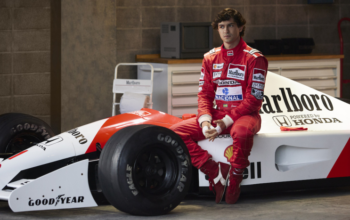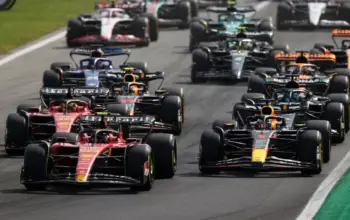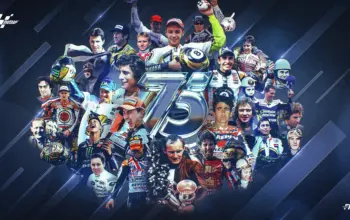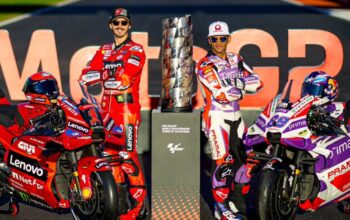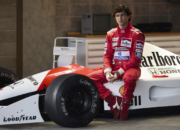Uzone.id – MotoGP supports the sustainability of the world’s future. As the pinnacle of world-class two-wheeled competition, everything developed in MotoGP has a positive impact on the sports industry, motorbikes, and a wider positive impact on the world.
Motorbikes are the most sustainable form of transport, and MotoGP is driving progress to innovate technology, as well as motorbike efficiency, aiming to reduce environmental impact.
MotoGP is committed to bringing a positive impact wherever it is held, as well as creating a competitive climate on the circuit to maintain sustainable ecosystems and the natural environment in the world.
Efforts for a sustainable future are realized by creating sustainable fuel. New motorbike regulations will start in 2027, plus innovations in electric motorbike racing in the MotoE class.
The MotoGP world championship will introduce new bikes from 2027. The new regulations are set to make the sport safer, more sustainable, and even more spectacular.
The new motorbikes will be more relevant on the road and more efficient, support global sustainability, and are designed to create better racing and more overtaking or jockeying for pole position.
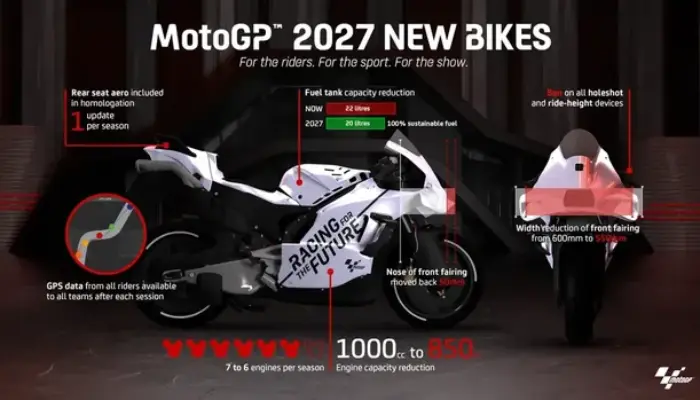
Machine
Starting in 2027, engine capacity will be reduced from 1,000cc to 850cc. This will lower the top speed, making the sport safer, and increase the distance traveled, making it more efficient.
The maximum cylinder bore will be reduced from 81mm to 75mm, which will also limit performance. This makes the machine more relevant on the road while ensuring the engine retains typical MotoGP characteristics.
To make the sport more efficient, the maximum engine allocation allowed for each rider in a season will also be reduced, from seven to six engines.
Fuel
As the FIM has announced, MotoGP will be raced on 100 percent environmentally friendly fuel from 2027, an increase from the minimum amount of 40 percent used since 2024.
As part of the new regulations, fuel tank capacity will also be reduced, from 22 liters to 20 liters, and racers will be allowed to use 11 liters during Saturday’s sprint race, or better known as the Tissot Sprint.
Aerodynamics
Aerodynamics will be reduced and more tightly controlled from 2027, to minimize their negative impact.
The upper width of the front fairing will be 50mm narrower and the nose will be pushed back 50mm, reducing the aero effect in important areas, the straights, and braking areas. This will create tighter races, with more overtaking action.
At the rear, the aero behind the rider will be part of the homologation from 2027, and teams will only be allowed to update it once per season to control costs.
Ride-Height and Holeshot Devices
In the new era starting in 2027, all ride-height and holeshot devices will be banned. This is to control performance and make the sport safer, especially when the race starts.
This will also place greater emphasis on the skills of each rider, such as aero which aims to improve overtaking ability.
Data GPS
To level the playing field, GPS data from all riders will be available to all teams after each session. Providing data to all competitors offers better advancement opportunities for underperforming teams and riders at a controlled cost.
Access to this wealth of data will help make the sport safer, and will also provide new sensations and experiences for fans around the world when watching MotoGP.
Concession
The current concession system, introduced late in the 2023 season, will continue. However, as the new technical regulations come into force in 2027, all manufacturers will start the season in Rank B.
They will then be rated again mid-season, in time for the summer of 2027, and can change their rating up or down to have access to more or fewer concessions.
This reactive system means that the manufacturer’s performance is taken into account from the first day or during free practice, to maintain as close competition as possible when the new era begins.
It is hoped that MotoGP in 2027 will be safer, more environmentally friendly, and even more spectacular than previous seasons.



